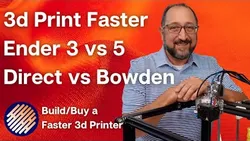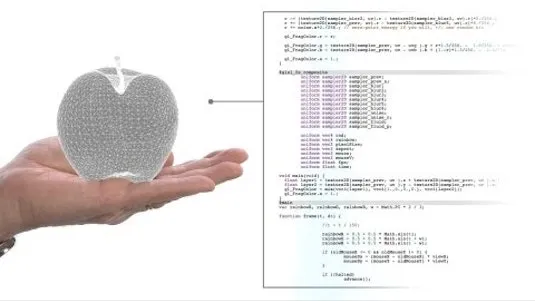
Faster 3d Printers Bowden vs Direct Extruder Creality Ender 3 v2 vs Ender 5 
This article compares two 3D printers, the Creality Ender 3 v2 and Ender 5, in terms of speed and architecture. It examines the differences between Bowden and Direct Extruders, and the advantages of an All Metal Hot End. The benchmark results show that the Ender 5 is faster than the Ender 3 v2, and that Cura profiles were used to optimize the printing process. ▼
ADVERTISEMENT
Course Feature
![]() Cost:
Cost:
Free
![]() Provider:
Provider:
Youtube
![]() Certificate:
Certificate:
Paid Certification
![]() Language:
Language:
English
![]() Start Date:
Start Date:
On-Demand
Course Overview
❗The content presented here is sourced directly from Youtube platform. For comprehensive course details, including enrollment information, simply click on the 'Go to class' link on our website.
Updated in [February 21st, 2023]
This course provides an overview of faster 3D printers, Bowden vs. Direct Extruder Creality Ender 3 v2 vs Ender 5. It covers topics such as setting up the speed benchmark, overall 3D printer architecture, Micro Swiss Direct Extruder, basics of Bowden vs. Direct Extruders, advantage of all metal hot end, benchmark results, Cura profiles used, Ender 3 vs Ender 5 profiles, impact of retraction on speed, direct extruder impact on federate, impact of acceleration parameters, and building a fast 3D printer. Participants will gain a better understanding of the differences between Bowden and Direct Extruders, and how to build a fast 3D printer.
[Applications]
The application of this course can be seen in the building of a fast 3d printer. After taking this course, users will have a better understanding of the overall 3d printer architecture, the basics of Bowden vs. Direct Extruders, the advantage of an all metal hot end, and the impact of retraction, direct extruder, and acceleration parameters on speed. With this knowledge, users will be able to build a fast 3d printer that is tailored to their specific needs.
[Career Paths]
1. 3D Printing Technician: 3D printing technicians are responsible for the operation and maintenance of 3D printers. They must be knowledgeable in the operation of the 3D printer, the materials used, and the software used to create 3D models. They must also be able to troubleshoot any issues that arise with the 3D printer. The demand for 3D printing technicians is increasing as 3D printing technology becomes more widely used.
2. 3D Printing Engineer: 3D printing engineers are responsible for designing and developing 3D printing systems. They must be knowledgeable in the principles of 3D printing, the materials used, and the software used to create 3D models. They must also be able to troubleshoot any issues that arise with the 3D printer. The demand for 3D printing engineers is increasing as 3D printing technology becomes more widely used.
3. 3D Printing Designer: 3D printing designers are responsible for creating 3D models for 3D printing. They must be knowledgeable in the principles of 3D printing, the materials used, and the software used to create 3D models. They must also be able to troubleshoot any issues that arise with the 3D printer. The demand for 3D printing designers is increasing as 3D printing technology becomes more widely used.
4. 3D Printing Consultant: 3D printing consultants are responsible for providing advice and guidance to businesses and individuals on the use of 3D printing technology. They must be knowledgeable in the principles of 3D printing, the materials used, and the software used to create 3D models. They must also be able to troubleshoot any issues that arise with the 3D printer. The demand for 3D printing consultants is increasing as 3D printing technology becomes more widely used.
[Education Paths]
1. Mechanical Engineering: Mechanical engineering is a field of engineering that focuses on the design, development, and production of mechanical systems. This includes the design and development of machines, engines, and other mechanical components. Mechanical engineers are also involved in the development of new materials and technologies, as well as the optimization of existing systems. Mechanical engineering is a rapidly growing field, with new technologies and materials being developed every day.
2. Computer Science: Computer science is a field of study that focuses on the design, development, and implementation of computer systems and software. This includes the development of algorithms, data structures, and programming languages. Computer scientists are also involved in the development of artificial intelligence, robotics, and other computer-related technologies. Computer science is a rapidly growing field, with new technologies and applications being developed every day.
3. Electrical Engineering: Electrical engineering is a field of engineering that focuses on the design, development, and implementation of electrical systems and components. This includes the design and development of circuits, power systems, and other electrical components. Electrical engineers are also involved in the development of new technologies, such as renewable energy sources, and the optimization of existing systems. Electrical engineering is a rapidly growing field, with new technologies and applications being developed every day.
4. Robotics: Robotics is a field of engineering that focuses on the design, development, and implementation of robotic systems and components. This includes the design and development of robots, sensors, and other robotic components. Robotics engineers are also involved in the development of artificial intelligence, machine learning, and other robotic-related technologies. Robotics is a rapidly growing field, with new technologies and applications being developed every day.
Course Provider

Provider Youtube's Stats at AZClass
Discussion and Reviews
0.0 (Based on 0 reviews)
Explore Similar Online Courses

Free CCNA OSPF Part 1 Day 26 CCNA 200-301 Complete Course

How I Use Notion as a Professor and Content Creator in Data Science (Template Included)

Python for Informatics: Exploring Information

Social Network Analysis

Introduction to Systematic Review and Meta-Analysis

The Analytics Edge

DCO042 - Python For Informatics

Causal Diagrams: Draw Your Assumptions Before Your Conclusions

Whole genome sequencing of bacterial genomes - tools and applications

Interactive 3D Graphics

Bioprinting: 3D Printing Body Parts


Start your review of Faster 3d Printers Bowden vs Direct Extruder Creality Ender 3 v2 vs Ender 5